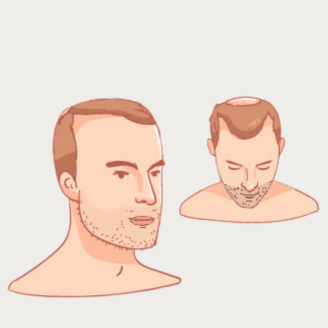Start Here
You have moved beyond the stage of denial and are ready to take action on your hair loss journey.
Whenever I thought about my hair loss situation and what I could do about it, I thought these were my only options.
Find the right hairstyle
Cut my hair short and wear a cap as often as possible
Try this Rogaine thing I've heard about (does it really work?)
Shave my head
However, there is (was?) such a negative perception of men going bald, that I never considered talking to anyone about it.
First I tried not to think about my hair loss - at all. Ignorance is bliss and all that. But when I did, I used the mental equivalent of holding my hands over my eyes and peeking though them - as if I was watching a scary movie. Because to really look at hair loss options was to admit I had a hair loss issue.
So congratulation for getting this far. Admitting there is (might be?) a problem, is the first step to taking back control of how you look.
Congratulations!
Norwood Scale of Baldness
The next step is to evaluate your specific stage of hair loss. In order to do this, we will employ a scale of baldness called the Norwood Scale.
This measurement scale was first introduced by James Hamilton in the 1950s and later revised and updated by Norwood in the 1970s. It is sometimes referred to as the Norwood–Hamilton scale or simply the Norwood scale.
The scale is regularly used by doctors to assess the severity of baldness, but it is not considered very reliable since examiners' conclusions can vary.
As you can see by the old-timey image below, the scale is comprehensive but at the same time, not very useful. There are clear differences between stages 1 and 3 but I think most of us would be fine having stage 3 (III) for the rest of our lives. Stage 4 is becoming an issue but again, if my hair loss did not progress beyond that stage, I would be OK. I can live in denial at stage 4 for a long time.
Stages 5 and 6 are where the alarms go off. This is not to say alarms were not going off at stage 3 but my knowledge of options was non-existent so my only real option was to ignore it. And to be honest, I didn't really look deeply into my option until I was somewhere between Stages 6 and 7.
Norwood Scale Variation
You can try to fit your current hairloss situation in the 1950's era Norwood scale, but I'd like offer you another option. Below are 3 examples of hairloss. They roughly break the Norwood scale into 3 main groups.
The first head represents Stages 1 to 3. The second head represents Stages 4 to 6. The last head is Stage 7 and beyond. Click on the head that you think most represents your current state of hairloss and you'll be taken to a page with the options available to you for that state.
Hair Loss Solutions Based on the Norwood Scale
If you didn't recognize yourself in any of the heads above, here is a list of solutions based on the Norwood Scale image above.
Stage 1 - This is a slight loss of hair at the temples. There is a natural transition from a "Juvenile" hairline and an "Adult" hairline. So don't mistake that transition as the beginning of you going bald. You might stay there the rest of your life. After all, male pattern baldness affects about 50% of males in the U.S. so it's possible you won't loose any more hair.
Stage 2 - This is more hairloss at the temples. Again, it might not be a sign of things to come (or go in this case).
Stage 3 - More loss at the temples but also a general moving back of the hairline. You might or might not feel a thinning at the back, or crown, of the head.
Stage 4 - A continuation of Stage 3. At this point it's probably safe to say you have male patterned baldness (androgenetic alopecia) and here are some solutions for you to consider:
Hair fibers (cover it up)
Hairstyle (hide it)
Laser cap (stop or reverse it)
Natural solutions (stop or reverse it)
Pharmaceutical solutions (stop or reverse it)
Toupee/Hair system (cover it up)
These last two are solutions that cannot be undone.
Micropigmentation (hide it)
Hair transplant (undo it)
Stages 5 to 7 are a continuation of your baldness. If the solutions you tried in the earlier stages did not work, then you can consider these more aggressive options:
Shaving your head
Micropigmentation
Toupee/Hair system
Hair transplant*
* It's unlikely you are a candidate for a hair transplant but it doesn't hurt to get some opinions. Contact several highly rated dermatologists who specialise in hair transplants.





